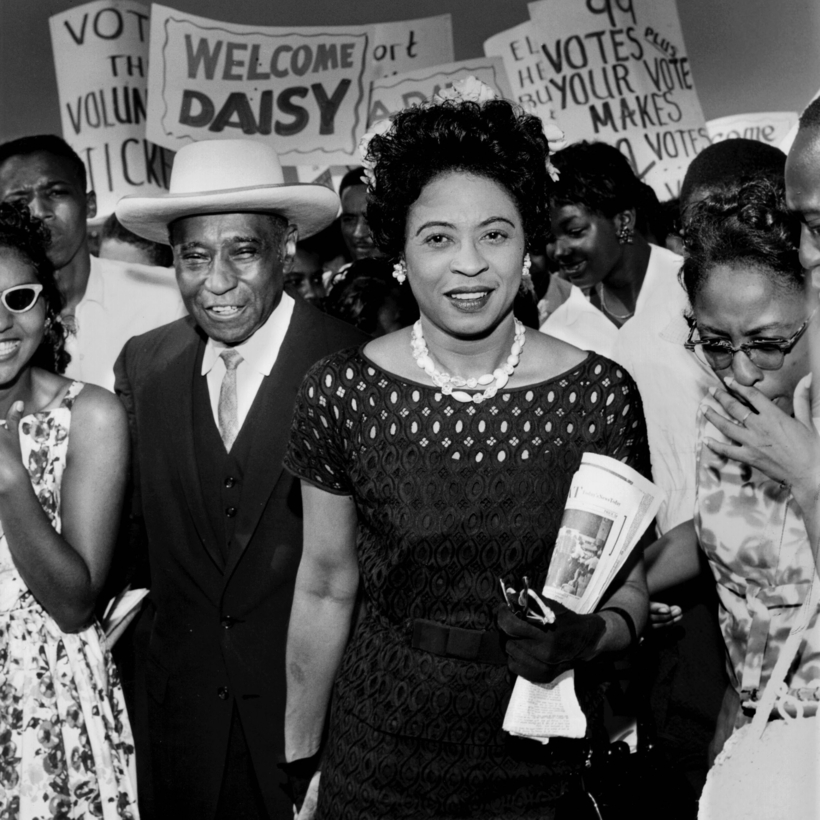The photograph, taken on the afternoon of August 28, 1963, is striking not only for who is pictured but for who is not. A study of the layering of power and powerlessness in American society, it shows the leaders of the civil-rights movement—including Dr. Martin Luther King Jr., John Lewis (then head of the Student Nonviolent Coordinating Committee), and Roy Wilkins, of the National Association for the Advancement of Colored People—posing with President John F. Kennedy in the Oval Office the day of the March on Washington.
No women appear in the photograph of the meeting because none were invited. That affront would raise the ire of Rosa Parks, who, according to her biographer the historian Douglas Brinkley, “found the entire event, including King’s soaring oratory, tainted by a male chauvinism every bit as ugly in its discrimination as Jim Crow.” The history books would note that the White House meeting included all the speakers at the march, but, in fact, one speaker was missing.
She was a last-minute addition to the official program at the Lincoln Memorial that Wednesday, and so her name—Daisy Bates—did not appear on the list of speakers. A civil-rights activist from Little Rock, Arkansas, Bates was an executive board member of the N.A.A.C.P. and a former president of the Arkansas chapter. She had also been the publisher, with her husband, of the Arkansas State Press, one of the most important Black newspapers in the South. Fiery and formidable, Bates—at the moment she stepped to the microphone to speak to the crowd of 250,000 gathered on the Mall—was among the best-known figures of the civil-rights movement.

Bates had gained national prominence six years earlier, during the landmark 1957 battle to integrate Little Rock’s all-white Central High School. Her face and voice, on television and radio, had filtered into living rooms throughout the country. She was on the cover of Jet magazine and named Woman of the Year by the National Council of Negro Women. Just a few months before the march, Bates’s memoir of the de-segregation fight was published. The Long Shadow of Little Rock included a foreword by Eleanor Roosevelt and was distinguished by being banned in bookstores throughout the South.
Daisy Bates, who was 50 years old in the summer of 1963, was one of the most controversial women of the civil-rights movement. She was ambitious and assertive—considered “pushy” by some and “aggressive” by others—and referred to as “Queen Daisy” by one N.A.A.C.P. attorney in a 1959 letter he copied to Roy Wilkins and Thurgood Marshall, then the group’s chief attorney. Almost modern in her mastery of the media, she was dismissed by others as an attention-seeker lacking in leadership skills. Regal in her bearing—imperious, some said—she was always impeccably mannered, and attired in fashionably cut suits and dresses and her signature three-inch heels. Unlike so many women of the movement, she was not inclined to be self-sacrificing; she also would not acquiesce to anyone who sought to put her in a subordinate role when she deserved the lead. And she was fearless.
Bates had gained national prominence six years earlier, during the landmark 1957 battle to integrate Little Rock’s all-white Central High School.
Bates first made headlines in 1956, during a public hearing in Little Rock on school de-segregation. She was president of the Arkansas N.A.A.C.P. at the time; nevertheless, as the prominent white lawyer representing the school district questioned Bates, he repeatedly referred to her by her first name. In the South, the disrespect wasn’t even coded: this was an age-old white tactic of belittlement. Bates interrupted the proceedings. Leaning into the microphone, she told the lawyer, icily: “You addressed me several times this morning by my first name. That is something that is reserved for my intimate friends and my husband. You will refrain from calling me Daisy.”

Her words echoed loudly. “For a black person to confront a white person in 1956 Little Rock publicly and in this manner was a shot across the bow of white supremacy in Arkansas and the South,” wrote Grif Stockley in his 2005 biography, Daisy Bates: Civil Rights Crusader from Arkansas. Bates was equally tough on Blacks—particularly Little Rock’s upper-crust Black establishment—who in her view were more interested in advancing themselves and their financial interests than in the struggle for full civil rights. When a white friend invited her to join the city’s integrated Urban League, Bates at first declined, according to Stockley, dismissing the League’s board as “just a bunch of n*****s who want to sit next to white folks once every two weeks.”
Bates was one of her generation’s early supporters of the lunch-counter sit-ins galvanizing younger civil-rights advocates as the 1960s began. She had become convinced that white domination would not yield without confrontation.
Eyes on the Prize
Years later, Bates would tell Elizabeth Jacoway, of the Southern Oral History Program, that “nothing prepared me more [for civil-rights work] than my anger. I was so tight inside,” she said. “There was so much hate.” Much of that arose from the mystery surrounding her parents. Born Daisy Lee Gatson in 1912 or 1913, Bates was raised by foster parents in Huttig, Arkansas, a segregated sawmill town. As a child, she was told that when she was an infant, her mother was raped and murdered by three white men. After that, she wrote in her memoir, her father “left town.” In the lethally wounded world in which Bates grew up—deep in the Jim Crow South—this added another layer of pain. There is some question as to whether the story is true; researchers have found no documentation to indicate that it was. But the records of Black lives in the Deep South are often unreliable or nonexistent. What is important, in the end, is that for Daisy Bates this account was true.
When she was still in her teens, Bates left Huttig to live with an insurance salesman by the name of L. C. Bates. They married several years later, after L.C. was divorced from his first wife. The years they lived together before their marriage would disappear in Daisy’s telling of her life story. The impropriety—for that era—of the affair bothered her deeply, as did her lack of a formal education past grade school. The latter she worked hard to correct, eventually taking college courses in business administration and public relations. Bates was a proud woman. She was also determined not to give her enemies any grounds to undermine her civil-rights work.
Unlike so many women of the movement, she was not inclined to be self-sacrificing; she also would not acquiesce to anyone who sought to put her in a subordinate role when she deserved the lead. And she was fearless.
In 1941, L.C. launched the Arkansas State Press, a weekly paper devoted to civil-rights advocacy. Daisy soon joined him in the newsroom, occasionally reporting stories, working on editorials, helping to run the business. He was buttoned-down, taciturn, analytical; she was passionate, an extrovert, unafraid to offend. Together the Bateses were a power in Arkansas civil-rights circles and in Little Rock. In 1952, Daisy became president of the Arkansas N.A.A.C.P. After the Supreme Court’s landmark Brown v. Board of Education decision two years later, which stripped away Constitutional sanction for racial segregation and “separate but equal” schools, Bates began a long, hard-fought campaign to build a coalition of students and parents to challenge the continued segregation of Little Rock’s schools.

Rocks were thrown through the Bateses’ windows; crosses were burned on their lawn; a bomb was found in their carport. With the arrival of federal troops in late September 1957, Central High was integrated (officially, at least), but the Bateses would pay a price for this victory: financially battered by an advertiser boycott organized by white companies that objected to the paper’s stance on school de-segregation, the Arkansas State Press was forced to close in October 1959.
The March on Washington was Daisy Bates’s last moment in the public eye. Initially, there were no plans to have women speak at the march. Only after an outcry from several of them did the male organizers decide to allow Myrlie Evers, the widow of the recently assassinated Mississippi N.A.A.C.P. activist, Medgar Evers, to say a few words. But Evers was hindered by travel delays, and so it was Bates—one of the most charismatic women of the movement—who stood at the microphone and uttered a mere 148 words, not her own but written by one of the march’s male organizers: “The women of this country pledge … to Martin Luther King, Roy Wilkins and all you fighting for civil liberties that we will join hands with you as women of this country.”
Bates did some of her most effective work in the years after the Washington march. In 1964, recruited to the job by President Lyndon Johnson, she ran successful voter-registration drives around the country for the Democratic National Committee. Two years later, after working for Arkansas’s economic-development office, Bates turned her sights on Mitchellville, a destitute, all-Black hamlet in the Delta. The town’s poverty was staggering. Raw sewage pooled in ditches at the side of dirt roads; 75 percent of the population was illiterate; fewer than half of the town’s 122 families had an annual income of more than $3,000.

Determined to transform it into a model of how Black poverty could be defeated, Bates moved into a mobile home in Mitchellville, where she lived almost full time for seven years, and set to work. She snared funds for a community center, a school, and for water and sewage treatment. She procured the town a fire truck and set up a dental clinic, a Head Start program, and job-training initiatives. Poverty was not eradicated, but by the time Bates left, in 1974, the town’s fortunes had improved greatly.
After her husband’s death, in 1980, Bates began her own slide into poverty. Propelled, perhaps, by a nostalgia for the excitement and relevance of her past, she tried to revive the Arkansas State Press, mortgaging her home to finance it. But the world had changed, and the paper soon failed, leaving Bates broke and ailing. She died in 1999. Bates would be eulogized by President Bill Clinton and honored in Arkansas. The rest of the country would largely forget about this extraordinary woman who was in many ways ahead of her time. In 1960, she refused to sing the national anthem before giving an Emancipation Day speech because she felt “great sadness” hearing the song in a country that was not yet “the land of the free.”
Suzanna Andrews is a writer living in New York City


